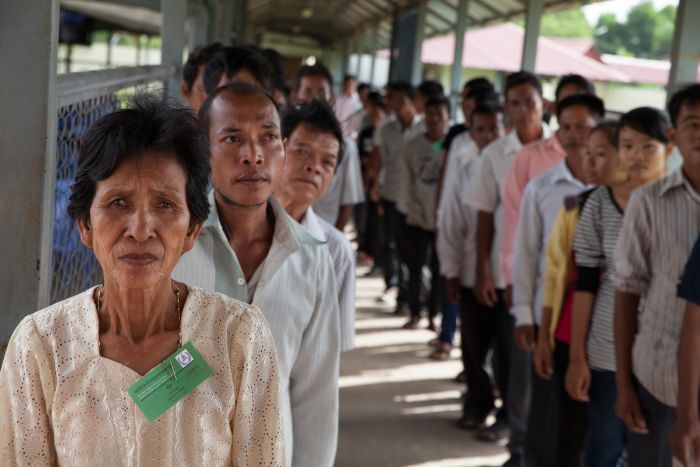
Getting Started
Be sure to review the Course Overview for framing language, notes on sensitive content, and other information relevant to instructors.
The “Lessons in Leadership'' course includes nine modules that explore the role of criminal justice professionals before, during, and after mass atrocities. The modules may be used individually or together. Individual modules may also be incorporated into existing programs or courses on related themes.
Download list of modules as PDF
Module 1: What are Mass Atrocities?
Time required: 1 hour
Participants will:
- Demonstrate an understanding of the definition of mass atrocities and the four types of mass atrocities.
- Learn about victim perspectives and articulate why preventing mass atrocities is important.
- Consider the challenges to atrocity prevention and possible intersections with the work of criminal justice professionals.
Materials
Module 2: Prevention: Identifying Risk Factors, Warning Signs, and Triggers
Time required: 45 minutes
Participants will:
- Gain a basic understanding of the risk factors, warning signs, and triggers for mass atrocities and identify examples in each of these categories.
- Be introduced to the Holocaust and apply a mass atrocity prevention lens to analyze events that led to the Nazi rise to power.
Materials
Module 3: Case Study: Criminal Justice Professionals and the Holocaust
Time required: 1 hour
Participants will:
- Describe the range of motivations that led criminal justice professionals to perpetrate or facilitate crimes during the Holocaust.
- Analyze how risk factors, warning signs, and triggers for mass atrocities intersect with the “slippery slope” as it relates to the participation of criminal justice actors in the Holocaust.
- Analyze the incremental decisions that ultimately led to the commission of mass atrocities.
- Evaluate the options available to criminal justice professionals when faced with warning signs for mass atrocities.
Materials
Module 4: Before Mass Atrocities: Criminal Justice Tools for Prevention
Time required: 30 minutes
Participants will:
- Relate the risk factors, warning signs, and triggers to their role as actors within the criminal justice system.
- Identify tools, sources of resilience, and other opportunities within their sphere of influence for preventing mass atrocities.
- Identify issues that surface before the onset of mass atrocities that are relevant for their work.
Materials
Module 5: Deeper Dive: Dangerous Speech OR Community Dialogues
Time required: 30 minutes
Option A: Tools for Addressing the Warning Sign of Dangerous Speech
Participants will:
- Gain a basic understanding of what qualifies as dangerous speech and how these topics intersect with early warning.
- Analyze how certain speech can escalate into acts of violence and reflect on their own roles and capabilities when addressing dangerous speech.
Option B: Community Dialogue as a Tool for Prevention
Participants will:
- Gain a basic understanding of what a community dialogue looks like and explore this as a possible tool for prevention.
- Share with each other their own experiences (where applicable) with holding community dialogues or pursuing other forms of community engagement, and exchange strategies for effective communication with community members to mitigate violence.
Materials
Module 6: Leadership, Motivations, and Rationalizations during Mass Atrocities
Time required: 1 hour with optional 5 minute add-on
Participants will:
- Understand basic concepts of leadership and articulate the meaning of ethical leadership.
- Discuss and reflect openly on common motivations, rationalizations, and vulnerabilities of criminal justice professionals in atrocity events.
- Reflect on the leadership qualities and actions they need to effectively address mass atrocity scenarios.
Materials
Module 7: First-Hand Testimony
Time required: 30 minutes
Participants will:
- Understand the human impact, both positive and negative, that the actions of criminal justice leaders can have on targeted groups. As a result, participants are motivated to dialogue with communities affected by mass atrocities appropriately and to engage these communities in their work.
- Demonstrate enhanced understanding of the key themes of the course and how they relate to criminal justice professionals.
- Identify potential challenges for criminal justice professionals attempting to prevent, mitigate, or address mass atrocities and possible ways to overcome these challenges.
Materials
Module 8: Redress for Mass Atrocities: The After Stage

Virtual Tour
Explore a virtual tour, "The Role of Professionals during the Holocaust in Budapest," created to complement the Module 8 materials.
Time required: 1 hour with optional 30–120 minute add-ons
Participants will:
- Identify the purpose of redress efforts after mass atrocities.
- Identify potential challenges and roadblocks to pursuing redress efforts and possible solutions.
- Display a basic understanding of key transitional justice tools, the benefits and potential drawbacks of each, and the potential role for criminal justice professions in implementing these tools.
Materials
Module 9: Action-Planning and Change Management
Time required: 95 minutes
Participants will:
- Connect the course themes, frameworks, and tools to their own professional realities.
- Leave the course with a draft action plan to help improve prevention.

